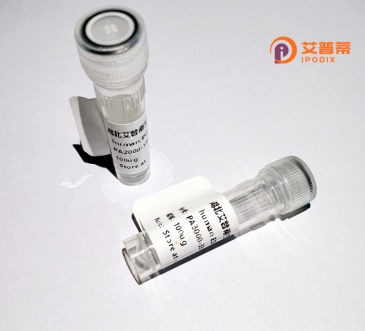
| 纯度 | >90%SDS-PAGE. |
| 种属 | Human |
| 靶点 | APPL |
| Uniprot No | Q9UKG1 |
| 内毒素 | < 0.01EU/μg |
| 表达宿主 | E.coli |
| 表达区间 | 1-709aa |
| 氨基酸序列 | MPGIDKLPIEETLEDSPQTRSLLGVFEEDATAISNYMNQLYQAMHRIYDAQNELSAATHLTSKLLKEYEKQRFPLGGDDEVMSSTLQQFSKVIDELSSCHAVLSTQLADAMMFPITQFKERDLKEILTLKEVFQIASNDHDAAINRYSRLSKKRENDKVKYEVTEDVYTSRKKQHQTMMHYFCALNTLQYKKKIALLEPLLGYMQAQISFFKMGSENLNEQLEEFLANIGTSVQNVRREMDSDIETMQQTIEDLEVASDPLYVPDPDPTKFPVNRNLTRKAGYLNARNKTGLVSSTWDRQFYFTQGGNLMSQARGDVAGGLAMDIDNCSVMAVDCEDRRYCFQITSFDGKKSSILQAESKKDHEEWICTINNISKQIYLSENPEETAARVNQSALEAVTPSPSFQQRHESLRPAAGQSRPPTARTSSSGSLGSESTNLAALSLDSLVAPDTPIQFDIISPVCEDQPGQAKAFGQGGRRTNPFGESGGSTKSETEDSILHQLFIVRFLGSMEVKSDDHPDVVYETMRQILAARAIHNIFRMTESHLLVTCDCLKLIDPQTQVTRLTFPLPCVVLYATHQENKRLFGFVLRTSSGRSESNLSSVCYIFESNNEGEKICDSVGLAKQIALHAELDRRASEKQKEIERVKEKQQKELNKQKQIEKDLEEQSRLIAASSRPNQASSEGQFVVLSSSQSEESDLGEGGKKRESEA |
| 分子量 | 79 kDa |
| 蛋白标签 | His tag N-Terminus |
| 缓冲液 | 冻干粉 |
| 稳定性 & 储存条件 | Lyophilized protein should be stored at ≤ -20°C, stable for one year after receipt. Reconstituted protein solution can be stored at 2-8°C for 2-7 days. Aliquots of reconstituted samples are stable at ≤ -20°C for 3 months. |
| 复溶 | Always centrifuge tubes before opening.Do not mix by vortex or pipetting. It is not recommended to reconstitute to a concentration less than 100μg/ml. Dissolve the lyophilized protein in distilled water. Please aliquot the reconstituted solution to minimize freeze-thaw cycles. |
以下是关于重组人DCC相互作用蛋白13-alpha (APPL1)的3-4条参考文献及其简要概括:
1. **文献名称**: "Identification of a chromosome 3p14.3-21.1 gene, APPL1. encoding an adaptor protein that interacts with the oncoprotein TCL1"
**作者**: Mitsuuchi et al.
**摘要概括**: 该研究首次克隆并鉴定了APPL1基因,发现其编码的蛋白包含PH和PTB结构域,可结合TCL1癌蛋白,并参与细胞增殖和凋亡的调控。
2. **文献名称**: "APPL1 interacts with the adiponectin receptors and mediates adiponectin signalling through Akt"
**作者**: Saito et al.
**摘要概括**: 研究发现APPL1直接与脂联素受体结合,通过调控AKT信号通路参与胰岛素敏感性和葡萄糖代谢,揭示了其在代谢疾病中的关键作用。
3. **文献名称**: "APPL1 links Aβ production to the pathogenesis of Alzheimer’s disease"
**作者**: Lin et al.
**摘要概括**: 该文献提出APPL1通过与γ-分泌酶复合物相互作用,促进β淀粉样蛋白(Aβ)的生成,阐明其在阿尔茨海默病病理机制中的潜在贡献。
4. **文献名称**: "APPL endosomes are not signaling endosomes but act as a transport compartment"
**作者**: Miaczynska et al.
**摘要概括**: 研究证明APPL1阳性内体并非传统信号传递载体,而是作为运输泡介导受体(如表皮生长因子受体)从细胞膜到核周的转运,影响基因表达调控。
(注:以上文献信息基于公开研究内容整合,具体作者和标题可能需根据实际出版物调整。)
APPL1 (Adaptor Protein, Phosphotyrosine Interaction, PH Domain and Leucine Zipper Containing 1), also known as DCC-interacting protein 13-alpha, is a multidomain adaptor protein first identified in 2002 for its interaction with the Deleted in Colorectal Cancer (DCC) receptor. It plays pivotal roles in diverse cellular processes by orchestrating signal transduction and membrane trafficking. Structurally, APPL1 contains an N-terminal phosphotyrosine-binding (PTB) domain, a central pleckstrin homology (PH) domain, and a C-terminal BAR (Bin/Amphiphysin/Rvs) domain, enabling interactions with receptors, lipids, and cytoskeletal components.
Functionally, APPL1 acts as a signaling hub, integrating pathways linked to cell proliferation, metabolism, apoptosis, and endosomal trafficking. It interacts with adiponectin receptors (AdipoR1/R2) to regulate insulin sensitivity and glucose metabolism, making it a key player in diabetes and obesity. APPL1 also mediates cross-talk between the Akt and Rab5 pathways, influencing growth factor signaling and vesicle transport. Additionally, it engages with membrane receptors like TRIM72 and TRAIL receptors to modulate cell survival, differentiation, and stress responses.
Dysregulation of APPL1 is implicated in metabolic disorders, cardiovascular diseases, neurodegenerative conditions (e.g., Alzheimer’s), and cancer. Genome-wide association studies (GWAS) link APPL1 variants to type 2 diabetes susceptibility. Its dual role in tumor progression—acting as a tumor suppressor or promoter depending on cellular context—underscores its therapeutic potential. Ongoing research aims to clarify APPL1’s context-dependent mechanisms and explore its utility as a biomarker or drug target.
×